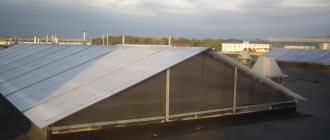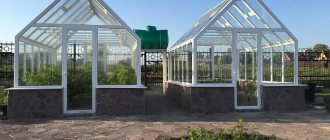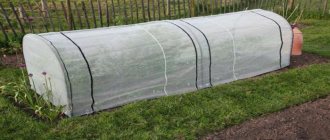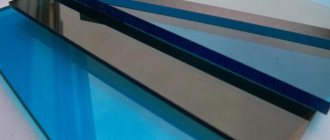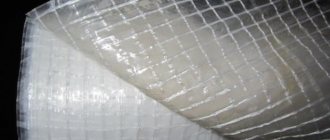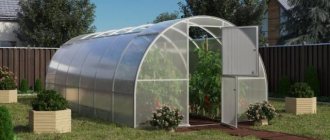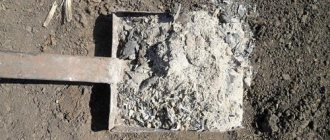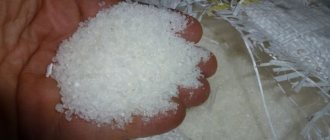Manufacturers in the construction industry are constantly delighting consumer developers with new products. One of these new products is polycarbonate, which appeared only a couple of decades ago, but today it is difficult to imagine how we managed without it before. It is used not only in the construction industry, but also in many other areas of industry and medicine, but it is in construction that polymer plastic is used so widely. What types of polycarbonate are there?
Nowadays, almost everyone knows that plastic can be cellular, profiled and cast. What’s remarkable is that they all have almost identical properties, thanks to which they are ahead of many other materials that have been tested for centuries on the market.
Features and benefits of polycarbonate
Polycarbonate, although it is a rather simple material, has a number of distinctive features from its analogues. The material itself is a small-thick solid sheet made, most often, from some kind of polymer or a mixture of them.
The sheets can be of completely different colors; there are translucent or completely transparent specimens. Polycarbonate is a fairly strong, dense and viscous material. All these qualities appear due to the injection molding technology of sheet bonding and special heat treatment.
It is the second procedure that adds impact resistance to polycarbonate, which is a very practical quality.
- But, this material is resistant not only to mechanical stress, it is also not afraid of various natural disorders.
- Polycarbonate reacts absolutely calmly to sudden changes in humidity and atmospheric pressure.
- Also, if you are making repairs in the off-season or in a room where the temperature changes sharply, then you don’t have to worry about the material deteriorating.
- Polycarbonate tolerates this absolutely calmly.
In addition to all of the above, polycarbonate is an extremely practical material. It easily changes its shape. If desired, you can round it or make it more compact in area.
This not only opens up enormous scope for imagination for creative builders, but it is also quite convenient, since you can save space when transporting material.
Cast or monolithic
This type of polycarbonate has the highest aesthetic characteristics. Visually, it is very similar to glass, but its strength qualities are hundreds of times greater: as tests have shown, a 12-mm cast sheet can even withstand a pistol shot. This fact serves as a clear example of the strength of the material, which is why it is used for the construction of those buildings where high demands are placed on the structure in terms of its load-bearing capacity.
Another important property of this polymer is its noise insulation characteristics, which is why monolithic panels are most often used to make noise barriers on highways.
Monolithic anti-abrasive polycarbonate is not exposed to external mechanical stress and therefore does not leave scratches.
Disadvantages of polycarbonate
But, no matter how good and time-tested polycarbonate is, it, unfortunately, also has weaknesses. You cannot remain silent about them, since ignorance of these points can cause a lot of problems for inexperienced builders.
And so, the main disadvantages of polycarbonate include:
- Poor chemical compatibility. Polycarbonate is quite complex from a chemical point of view. All polymer compounds that make up this material undergo a wide variety of chemical reactions. They do not always have a favorable effect on the appearance of polycarbonate. Most often, this happens when you use a detergent or treat the surface of the material with something. Chemical stains may remain, which are extremely difficult to wash off. To prevent this, carefully read the chemical composition of all detergents and processing fluids.
- Price. This is probably the main drawback, so you definitely shouldn’t ignore it. No one wants to increase the cost of repairs too much, since this in itself is quite expensive. But, you have to pay for quality and solid appearance. On average, the price for polycarbonate is from 2,500 rubles per sheet. Of course, you can save money by purchasing a low-quality product from a dubious manufacturer, but such material will quickly fail and you will need to purchase a new one again.
It is better to immediately purchase high-quality polycarbonate that will last a long time.
Specifics of working with the material
- Before screwing simple self-tapping screws into polycarbonate, you need to drill holes. Their diameter should be 1–2 mm larger than the diameter of the screw.
- The self-tapping screw should not be tightened too much: the sheet should be able to move under conditions of changing temperature conditions.
- When working with polycarbonate sheets, care should be taken to avoid damaging the top protective layer.
- During installation, taking into account the presence of hollow channels in polycarbonate, the rules must be followed: the channels must run parallel to the bend, the slope of the roof, and in the case of vertical structures - vertically. In this form, the material will be protected from deformation during operation.
- All work is carried out on a smooth surface using sharpened tools. The protective film should not be removed before cutting or drilling to prevent small particles from entering the channel cavity. The same tools are used for cutting as for plastic or wood.
Types of polycarbonate
There are three main types of polycarbonate according to size and shape:
- Profiled polycarbonate
- Cellular polycarbonate
- Multi-chamber polycarbonate
Each type is unique in its own way and requires separate consideration.
Price overview
Below are approximate prices for polycarbonate sheets (the final prices depend on the type, thickness, size and manufacturer).
- Sheet thickness 3.5 mm: size 2.1 x 6 m - price is 1,250 rubles; 2.1 x 12 m – 2,500 rubles.
- Sheet thickness 6 mm: size 2.1 x 6 m – 2,400 rub. (transparent), RUB 2,625. (color); 2.1 x 12 m – 4,800 rub., 2,400 (transparent), 5,800 rub. (color).
- Sheet thickness 10 mm: size 2.1 x 6 m – 3,400 rub. (transparent), RUB 3,675. (color); 2.1 x 12 m – 6,800 rub. (transparent), RUB 7,350. (color).
- Sheet thickness 16 mm: size 2.1 x 6 m – 5,900 rub. (transparent), 6,300 rub. (color); 2.1 x 12 m – 11,800 rub. (transparent). 12,600 (color).
- Sheet thickness 32 mm: size 2.1 x 6 m – 9,250 rub. (transparent), RUB 10,175. (color); 2.1 x 12 m – 18,500 rub. (transparent), RUB 20,350 (color).
Profile polycarbonate
The advantages of this material include its excellent light transmittance. This quality makes profile polycarbonate the absolute leader in the market of materials for greenhouses and conservatories.
But such material cannot be used to build greenhouses, since the main function of these indoor spaces will be lost; a roof made of profile polycarbonate does not create shade. Sheets of this material have an unusual, but very practical wave-like shape.
PC History
A material similar in description to polycarbonate was first mentioned back in the 19th century. It is reliably known that in 1898, the German chemist A. Einhorn first described the mechanism of PC synthesis.
However, polycarbonate received commercial use in the 1950s, when it was synthesized by Hermann Schnell, who worked at the still famous company BAYER (Germany). Bayer and received the first patent for a PC under the trade name Makrolon. Around the same years, another technology for synthesizing PC was developed; it used bisphenol A as a raw material. This technology was used by Mobay (trade name MERLON) and General Electric (brands Lexan and Nalgene).
Large-scale production of polycarbonates started in the 1960s, and a few years later, the most famous PC-based material today, cellular polycarbonate, appeared. This material, which combines the properties of sheet and profile, is sold worldwide under dozens of brands, including Lexan, Makrolon, Bayblend, Makroblend, Trirex and others.
Cellular polycarbonate
This type of polycarbonate is the most popular among all presented. It transmits sunlight quite well, but retains heat. Cellular polycarbonate can also be used to build walls and ceilings in greenhouses.
The material from which cellular polycarbonate is made is quite complex, which makes it more expensive than its profile analogues. This material has a layered structure. There are quite a few types of cellular polycarbonate.
Mainly the following copies are shared:
- 2R. The number before the letter indicates the number of layers. As you can understand, the minimum number of layers in a sheet of cellular polycarbonate is 2. A fairly practical specimen, suitable for renovation in a summer kitchen or gazebo, as it conducts heat well. Overall, a good summer option for inexpensive polycarbonate. Easy to use and great for first time renovations by inexperienced builders, assembly of this polycarbonate is quite simple.
- S. This symbol means that the basis of the shape of a sheet of this type of cellular polycarbonate is a sinusoid. This specimen is made of a denser and more resistant material. More suitable for winter work, but also costs more. This polycarbonate is more monolithic and heavier than its counterparts.
Supplier selection
It is very important when choosing polycarbonate to choose a responsible supplier. This is quite simple to do; when choosing, you need to take into account some criteria:
- A conscientious supplier who respects himself and his clients seeks an approach to each buyer.
- A responsible supplier will never prove to the buyer that there is no difference between brands of polycarbonate.
- A responsible, honest seller will recommend not only the appropriate, but also the best polycarbonate, and will advise you to additionally purchase the necessary components.
In addition, an experienced seller will advise which brand of polycarbonate is best to purchase and provide all the necessary documentation.
Multi-chamber polycarbonate
A rather complex type of polycarbonate, which is used in complex and large-scale projects.
- The main advantages of this material include its flexibility, strength, practicality and resistance to mechanical and thermal damage.
- Of the minuses, cost and size, multi-chamber polycarbonate is really quite large and its sheets take up a lot of space.
- If you purchase high-quality multi-chamber polycarbonate from a trusted manufacturer, you can be sure of durability.
In general, it is impossible to single out the best option for polycarbonate; everyone chooses depending on their preferences and needs.
Recycling
When processing polycarbonates, most methods of processing and molding thermoplastic polymers are used: injection molding (product production), blow molding (various types of vessels), extrusion (production of profiles and films), melt molding of fibers. In the production of polycarbonate films, solution molding is also used - this method makes it possible to obtain thin films from high molecular weight polycarbonates, the molding of thin films from which is difficult due to their high viscosity. Methylene chloride is usually used as a solvent.
Photo of using polycarbonate
Polycarbonate film
One of the most useful properties of PC film is its dimensional stability. Heating a polycarbonate film for 10 minutes at a temperature of 150°C results in a linear reduction in its size by no more than 2 percent.
Polycarbonate film is well welded by various methods, such as thermal contact welding, ultrasonic and others. It is well formed, stretched and printable. High-quality designs on polycarbonate film are obtained using various technologies, such as silk-screen printing, flexo printing, etc.
Its disadvantage is its high gas and vapor permeability, which necessitates the application of a special coating to the film to improve its barrier properties.
Specifications
The width and length of the sheet are the necessary characteristics, but the scope of application of this plastic depends on the thickness. Professional builders avoid products with a thickness of less than 4 millimeters , trying to use them only for decoration and small structures.
Depending on the purpose and thickness, the following divisions are proposed:
- 4 mm - for greenhouses, canopies, canopies, provided that there are no strong winds or snowfalls in the region;
- 6 mm - for greenhouses, oversized canopies and canopies;
- 8 mm - for parking canopies, stops, fences, etc., where it is necessary to prevent damage to property or where reliable shelter from bad weather is needed, as well as protection from vandals;
- 10 mm - for large-scale construction, facades, pavilions;
- 16 mm - on the roof of a building and on objects for public use.
The width of the polycarbonate sheet, as well as the length, must first be taken into account when calculating. Thickness indicates the likelihood of using the material you like.
